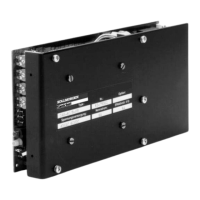III Functions and Options
III.1 Important notes
n
Alterations to the transistor controller can only be carried out by professionally qualified
personnel.
Setting and optimisation of the transistor controller, and the configuration of circuit blocks
by using the solder links is permitted.
Any further manipulation will invalidate the guarantee.
n
The controller must be recommissioned after every alteration. See Chapter II.3 .
III.2 Description of the functions
III.2.1 Input functions
III.2.1.1 Setpoint inputs SW1, SW2
The transistor controller has two non-interacting differential inputs for the setpoints.
Input 1 has a fixed setting for differential input voltages of max. ± 10 V.
Input 2 is equipped with an adjustable attenuator (P 2),
range of adjustment 0 — 100%
— clockwise rotation increases the speed (increasing effect)
— a positive voltage on terminal 1 relative to terminal 2, or on terminal 3 relative to
terminal 4 causes a clockwise rotation of the motor (looking at the shaft end) if it
is correctly connected.
The common-mode voltage range (important to avoid earth loops) is an additional ±10V
for both inputs, the input resistance is 20 kW.
III.2.1.2 Tachometer input Ta
P1 is provided for fine adjustment of the tachometer, the range of adjustment is 8 — 75V.
The fixed resistor R106 determines the tachometer normalisation.
The standard components installed are dimensioned for tacho voltages of 8V or 75V at a
setpoint voltage of 10V and with P1 on the right stop or left stop respectively.
Increasing R106 increases the tachometer voltage range.
Chapter III Functions and Options Page III - 1
Kollmorgen 12.99 Series 04S

